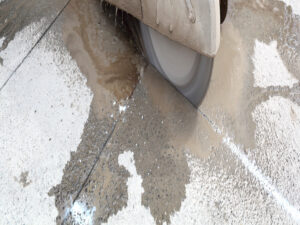
Wire, often laced with diamond beads for supported strength, runs through a hydraulic or electric-powered pulley system at speed.
Wire sawing refers to wire cutting through massive pieces of wood. This concept can be hard to imagine, but it’s a contemporary cutting technique with many benefits. A wire saw can even cut underwater. Concrete Visions can answer a lot of questions for you regarding this seemingly impossible cutting method. Here are the need-to-knows regarding wire sawing.
What is Wire Sawing?
Wire, often laced with diamond beads for supported strength, runs through a hydraulic or electric-powered pulley system at speed. You can compare a wire saw to bandsaw-like cutters. However, a wire saw doesn’t have many jagged teeth. Instead, a wire saw uses friction.
The advanced cutting process happens because of the wire cutting at speed. A wire saw can cut through robust materials with almost any level of thickness. The wire threads through a previously core drilled hole and pulls through the concrete.
The purpose of wire sawing is to remove large and reinforced concrete segments. The wire usually consists of high tensile steel or robust synthetic rubber connected by a mechanical joiner. Diamond saws can cut through anything softer than a diamond, virtually every material on the planet.
A wire saw consists of one or more braided strands that make a single cable. The diamond beads attach to the outside of this cable. An elastomeric compound coats the wire saw, protecting the diamonds and the wire from corrosion.
What Can a Wire Saw Cut?
A wire saw cuts through concrete and reinforced concrete, but it also cuts through:
- Steel
- Brick
- Granite
- Stone
What Are Some Wire Sawing Applications?
You can use wire sawing to your advantage in a wide range of construction projections. Some of these applications include
- Demolition sites
- Dismantling mining sites and equipment
- Cutting through concrete structures such as bridges, dams, factory floors, jetties, columns, and beams
- Angular cuts on horizontal and vertical structures
- Precision cuts on confined, restricted, and sensitive areas
- Cut through embedded steel and heavy rebar
- Cutting circular openings
- Subsea cutting (cutting underwater) of conductors, pipelines, and other underwater structures
The Benefits
Professionals consider wire sawing to be a state-of-the-art cutting technique for many reasons, such as:
- A wire saw cuts through far more than traditional cutting methods.
- Its resilience and flexibility to cut at almost any angle in any position
- Almost faster, less vibrational, fumeless, and quieter than other sawing methods
- Typically produces less waste
- Creates less dust in the air
- User-friendly and requires less labor
How to Determine if Wire Sawing is Best for Your Project
Ask yourself these questions:
- Am I dealing with high traffic, sensitive area?
- Is this a massive piece of concrete?
- Am I working with reinforced concrete?
- Is the concrete in a challenging position to cut/remove?
Contact Concrete Visions today to learn about the best concrete cutting techniques for your construction projects.
Concrete Visions Will Get The Job Done Right
Concrete Visions has been working with clients for over 25 years. Our G&M Services installers are certified with the industry’s major firestop product manufacturers. As part of our firestop service, we can assess abnormal field conditions and, with the manufacturer’s technical support assistance, provide engineering judgments in a timely fashion to comply with contract specifications. Our Field Mechanics undergo ongoing training, including mandatory monthly safety meetings, weekly Toolbox Talks where safety and equipment information is shred, and trainings on safe work standards and safety best practices.
